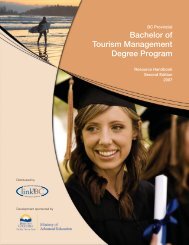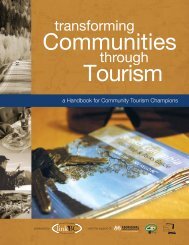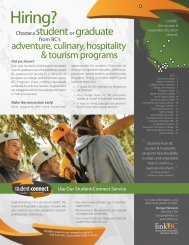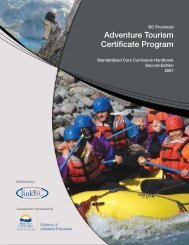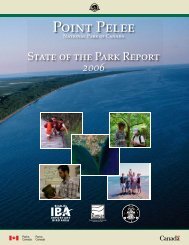Cultural Heritage Tourism Handbook - LinkBC
Cultural Heritage Tourism Handbook - LinkBC
Cultural Heritage Tourism Handbook - LinkBC
- No tags were found...
Create successful ePaper yourself
Turn your PDF publications into a flip-book with our unique Google optimized e-Paper software.
1.2 Considering the Fit for Your Community2. Defining <strong>Cultural</strong>/<strong>Heritage</strong> <strong>Tourism</strong>With Dr. Simard’s words in mind, let’s get started! One of the most important elements in cultural/heritage tourism is community fit. That’s because travellers are changing, and many communitiesare doing their best to understand and adapt to these trends.Travellers are ChangingAs communities consider diversifying their economies throughtourism, they need to be aware of the changing desires of manytravellers. Today, an increasing number of consumers want:• Safe destinations.• Meaningful, authentic experiences.• The ability to ‘participate’ rather than ‘observe’.• A chance to meet locals.• Quality in concert with good value.• Comfort, and softer adventure activities.• Unique products and customized experiences.• Last-minute getaway opportunities, with suggested itineraries.• The opportunity to plan online.• Opportunities to support good environmental and social responsibilitypractices. 1This kind of visitor travels to experience a wide range of authenticattractions and services unique to the destination.Communities are RespondingAcross Canada many communities have become high-appealtourism destinations by attracting this type of visitor. They’ve seenthat cultural/heritage tourism supports local business, helps diversifytheir economies, and improves quality-of-life for local residents.Consider this list of Canadian communities:• Trinity, NF• Charlottetown, PE• St. Andrews, NB• Lunenburg, NS• Quebec City, QC• Stratford, ON• Ft. Garry, MB• East End, SK• Rosebud, AB• Nelson, BC• Dawson City, YTThese places all increased visitor revenue by nurturing the historicaland cultural assets unique to their region. Through effective partnerships,planning and promotion, they created jobs and economicactivity through cultural/heritage tourism.At this stage you might want to ask yourself:• Is a focused effort to develop cultural/heritage tourism right formy community NOW?• If we have established cultural/heritage attractions, are we readyfor a more holistic, community-based approach to improving ourappeal as a destination?If the answer to the above questions is “yes”, then the rest of thishandbook is for you. Becoming a cultural/heritage tourism destinationtakes time, resources, and creative thinking. You won’t be anexpert after reading this, but you should be able to start discussionsand establish a plan to produce results.Let’s turn our attention to the sector. What is cultural/heritagetourism? And how did it evolve to be an important economicgenerator?This chapter explores the evolution of cultural/heritage tourism, including definitions, economicimpacts, and products/experiences that comprise the sector.2.1 The Birth of a New Economy<strong>Cultural</strong>/heritage tourism opportunities have come to be, in large part, because of Canada’s economictransformation over the past 30 years.We’ve moved from resource extraction and processing to a mixedserviceseconomy that spans from agriculture to animation, fromfinance to forestry, and from tourism to technology. Natural resourcerevenues from oil, gas, minerals, timber, and electrical energy arestill vital contributors to the national economy, but fewer peoplenow work in these industries.There’s been a fundamental shift toward a knowledge-basedeconomy – where an educated population provides our competitiveadvantage, and drives what we have to sell on local andworld markets. Of particular interest to tourism is the emergence ofwhat Richard Florida 2 calls the creative economy, where visual andperforming arts, heritage, and cultural activities of various kindsbecome economic drivers.In addition, a significant tourism product shift is being driven bythe aging of our population, with their increased interest in arts,heritage and cultural tourism.What is <strong>Tourism</strong>?Finally, the global tourism climate is changing. A ‘thickening’ USborder combined with a global economic downturn has forceda re-think about markets and the changing demand for tourismproducts. What is the best approach for rebuilding lost business?What emerging markets can be developed? How can the unique“sense of place” of a community or region be further developed toattract new visitors? And most importantly for this handbook, whatis the role of arts, culture, and heritage attractions/events in buildinga thriving and diverse tourism economy in your community?2.2 Defining our SectorsBefore we answer these questions, let’s provide a brief overview oftourism, and cultural/heritage tourism.People are motivated to travel for a wide range of reasons: reuniting with family, escaping acold winter, rejuvenating at a spa, or experiencing a different culture or cuisine.The tourism economy includes everything from a visitor’s mode oftravel, to meals, lodgings, and activities they engage in during theirtrip. With so many products and services catering to the needs oftourists, it’s not surprising that tourism is now considered the largestindustry in the world.There are many ways of defining tourism, but a commonly accepteddefinition is the one developed by the United Nations World <strong>Tourism</strong>Organization (UNWTO):“The activities of personstravelling to and staying inplaces outside their usualenvironment for not more thanone consecutive year for leisure,business, and other purposes.”6 7



